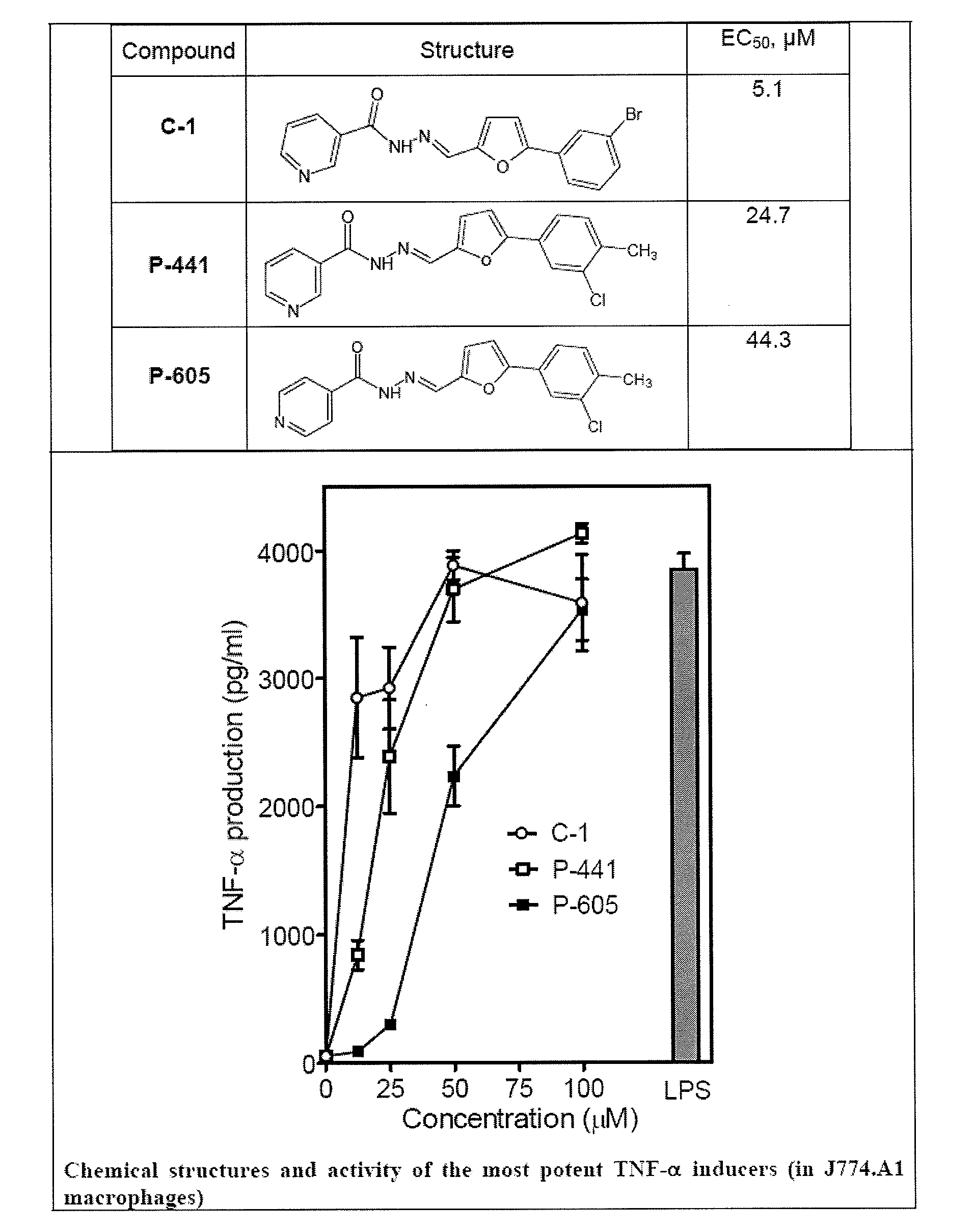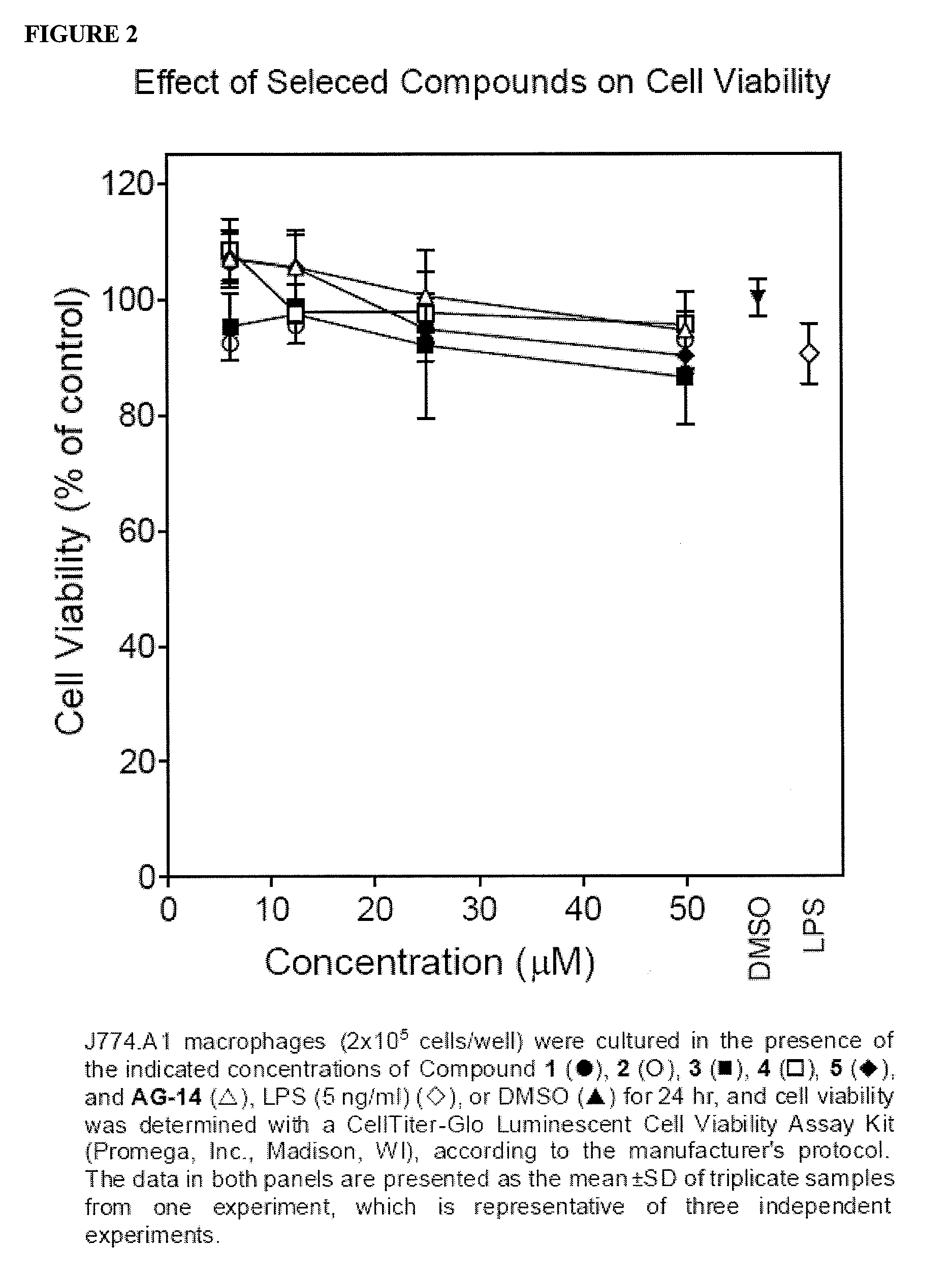Novel formyl peptide receptor like 1 agonists that induce macrophage tumor necrosis factor alpha and computational structure-activity relationship analysis of thereof
- Summary
- Abstract
- Description
- Claims
- Application Information
AI Technical Summary
Benefits of technology
Problems solved by technology
Method used
Image
Examples
example
Example 1
Materials and Methods of the Present Invention
Materials
[0124]All synthetic small-molecule compounds were obtained from TimTec Inc. (Newark, Del.). 8-Amino-5-chloro-7-phenylpyridol [3,4-d]pyridazine-1,4(2H,3H)-dione (L-012) was obtained from Wako Chemicals (Richmond, Va.). Actinomycin D (ActD), cycloheximide (CHX), concanavalin A, dimethyl sulfoxide (DMSO), ethylenediaminetetraacetic acid (EDTA), ionomycin, horseradish peroxidase (HRP), N-formyl-Met-Leu-Phe (fMLF), Percoll, 4-(2-hydroxyethyl)-1-piperazineethanesulfonic acid (HEPES), Histopaque 1077, Histopaque 1119, lipopolysaccharide (LPS) from Escherichia coli K-235, and phorbol 12-myristate 13-acetate (PMA) were purchased from Sigma Chemical Co. (St. Louis, Mo.). IL-8 and keratinocytederived chemokine (KC) were obtained from PeproTech Inc. (Rocky Hill, N.J.). Pertussis toxin (PTX), WKYMVm, and human GM-CSF were purchased from Calbiochem (San Diego, Calif.). Fura-2AM was from Molecular Probes (Eugene, Oreg.). The receptor ...
example 2
Identification of TNF-α Inducer
[0139]Previously, the present inventors screened a chemolibrary of drug-like molecules for their ability to activate reactive oxygen species (ROS) production by phagocytes and identified 26 such agonists (designated here as agonists (AG) 1-26, see Schepetkin et al., 2007).
[0140]The present inventors evaluated whether these compounds also induced phagocyte TNF-α production and found that five compounds induced modest levels of TNF-α production by murine J774.A1 macrophages (Compounds AG-1, -3, -8, -14, and -15 in Table 1). Since the two most potent compounds (AG-3 and AG-14 in Table 1) are both arylcarboxylic acid hydrazides (see Table 1), the inventors focused on this scaffold and selected analogs for each of these two agonists for further screening.
TABLE 1Effect of Arylcarboxylic Acid Hydrazide Derivatives on TNF-αProduction in J774.A1 Macrophages and Ca2+ Mobilization in Human Neutrophils[Ca2+]iTNF-αEC50NumberStructureproductiona(μM)LogPc140-500.32.8...
example 3
Effect of TNF-α Inducers on Phagocyte Chemotaxis and ROS Production
[0145]Previously, the inventors found that treatment of phagocytes with two arylcarboxylic acid hydrazides (AG-14 and AG-104) stimulated phagocyte chemotaxis (Schepetkin et al., 2007). Thus, the inventors evaluated the effects of Compounds 1 and 2 on this response in murine and human phagocytes. Both of these compounds were found to be neutrophil chemoattractants and dose-dependently induced human as well as murine neutrophil migration (FIG. 6), although the magnitude of these responses was generally lower than those induced by IL-8 or KC for human and murine neutrophils, respectively (Table 3). In comparison, maximal chemotaxis toward Compound AG-14 was equal to or much higher than the response induced by IL-8 or KC, respectively. Note that the dose-response curves for murine neutrophil chemotaxis were bellshaped; whereas, the chemotactic responses of human neutrophils increased with increasing dose of compounds up ...
PUM
| Property | Measurement | Unit |
|---|---|---|
| Volume | aaaaa | aaaaa |
| Molar density | aaaaa | aaaaa |
| Molar density | aaaaa | aaaaa |
Abstract
Description
Claims
Application Information
 Login to View More
Login to View More - R&D
- Intellectual Property
- Life Sciences
- Materials
- Tech Scout
- Unparalleled Data Quality
- Higher Quality Content
- 60% Fewer Hallucinations
Browse by: Latest US Patents, China's latest patents, Technical Efficacy Thesaurus, Application Domain, Technology Topic, Popular Technical Reports.
© 2025 PatSnap. All rights reserved.Legal|Privacy policy|Modern Slavery Act Transparency Statement|Sitemap|About US| Contact US: help@patsnap.com



